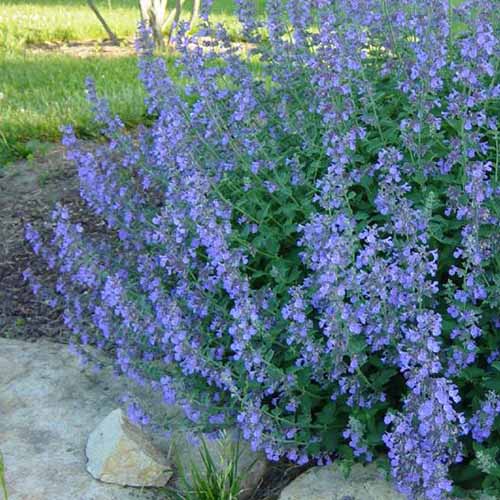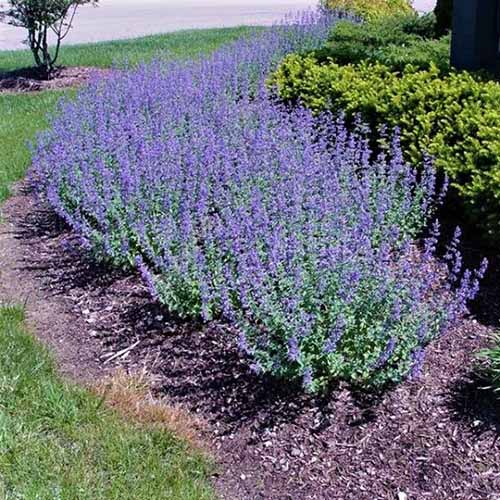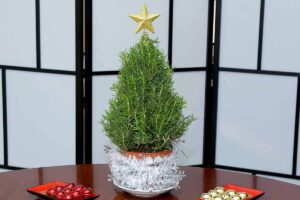Nepeta spp.
Nepeta is a genus of flowering perennials in the mint family, including popular herbs such as catnip and Faassen’s catmint.
Many feature attractive aromatic foliage and long blooming flowers that pollinators love.
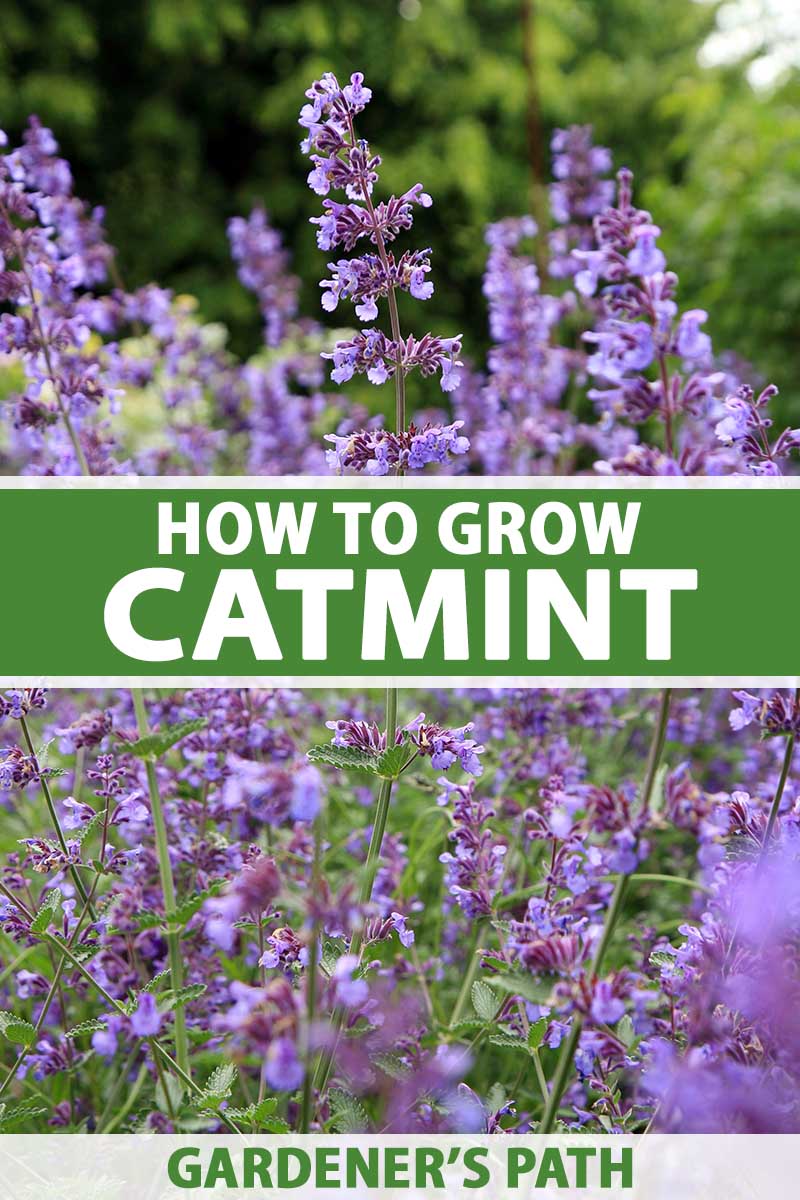
We link to vendors to help you find relevant products. If you buy from one of our links, we may earn a commission.
What’s more, with very few pests or other issues to worry about, these hardy perennials are incredibly easy to grow!
Continue on to learn all about growing catmint plants.
What You’ll Learn
What Is Catmint?
The Nepeta genus includes 250 species of herbaceous perennials as well as a few annuals, with about 20 of these species and cultivars currently in cultivation.
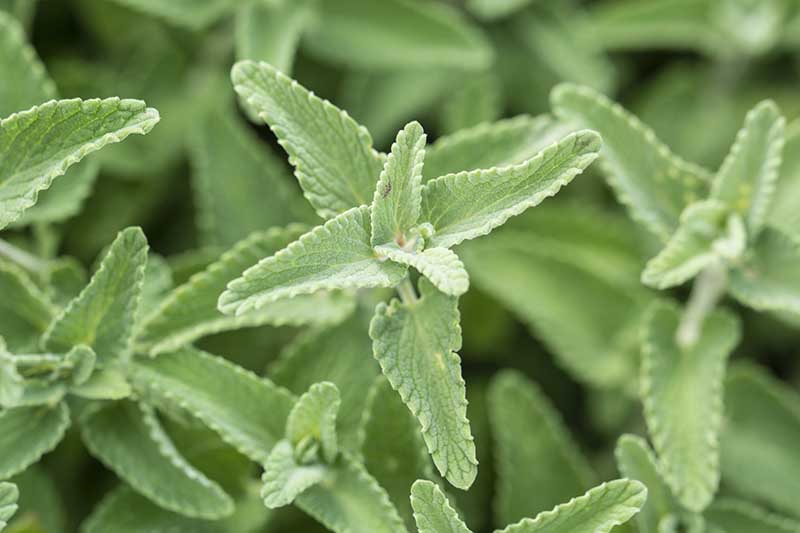
They are often found in the wild growing in dry, sunny areas, often in dry rocky soils in USDA Hardiness Zones 3 to 9.
Species in this genus are drought resistant, requiring significantly less water than some other mints.
The genus contains several commonly grown species, most of which have aromatic heart-shaped green to gray-green foliage with opposite leaves, square stems, and small tubular flowers in shades of lavender, white, pink, or blue that bloom from spring through fall.
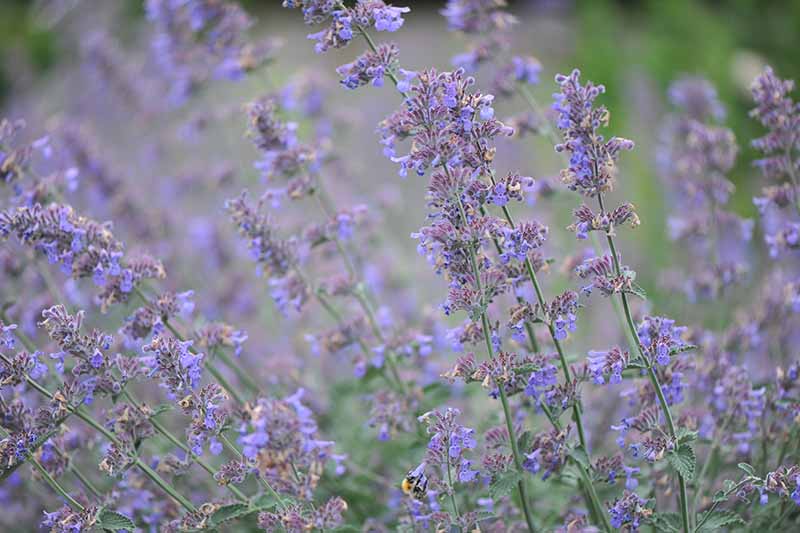
Some popular ones include catnip (Nepeta cataria), Persian catmint (N. mussinii), and Faassen’s catmint (N x faassenii).
Though to make matters confusing, the common names “catnip” and “catmint” are used to refer to multiple species.
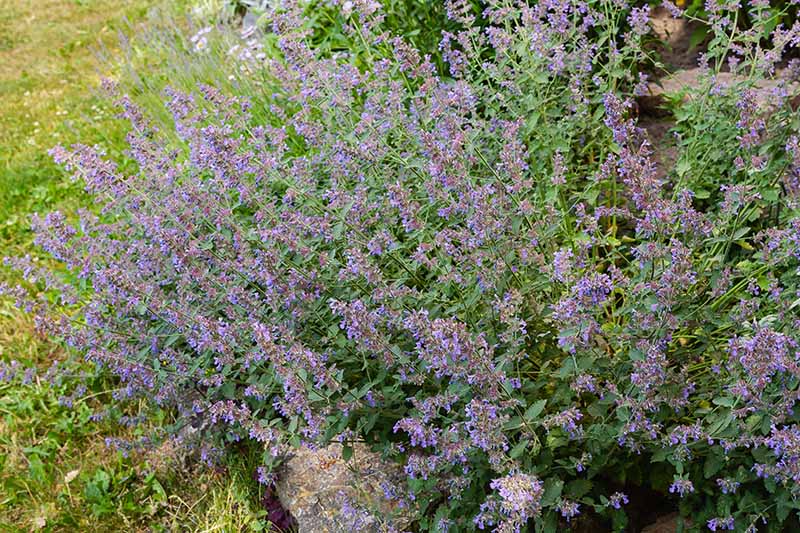
N. cataria, commonly known as catnip, catwort, or catmint, is a traditional medicinal herb and the one we typically use to intoxicate our cats, though others in the genus may be attractive to felines as well.
It has a bit of a weedier appearance than some other species.

N. racemosa (aka N. mussinii) is also referred to as catmint, dwarf catnip, or raceme catnip.
A lower growing perennial with lilac-colored flowers, it is often grown as a border or ground cover in flower beds.
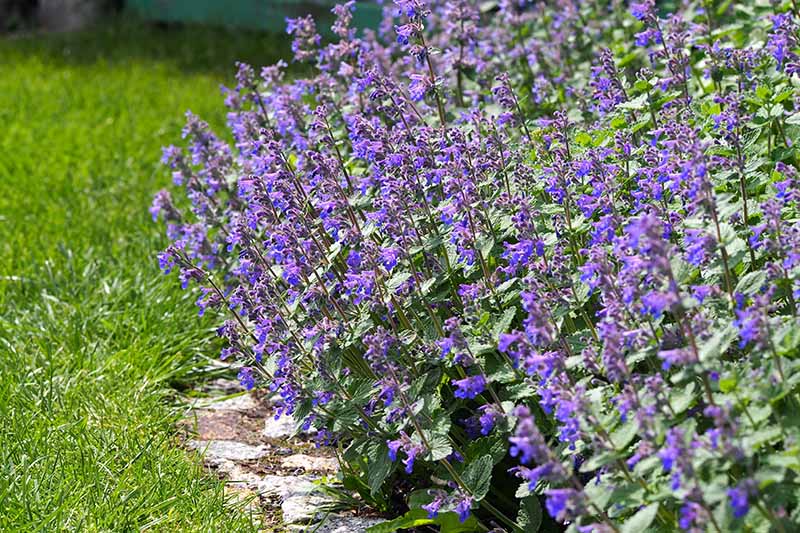
N. x faassenii, an N. racemosa hybrid also known as Faassen’s catmint, is a compact mounding hybrid with small but attractive lavender flowers. It is also grown primarily for its ornamental value.
You can learn more about how to grow Faassen’s catmint in our guide.
Cultivation and History
Species in this genus can be traced to Europe, Asia, and Africa, and many have naturalized in North America and throughout the world. N. cataria was first brought to North America in the 1800s by settlers who used it as a culinary herb.
Many Nepeta species are cultivated as ornamentals, for food, medicine, and of course, for cats!
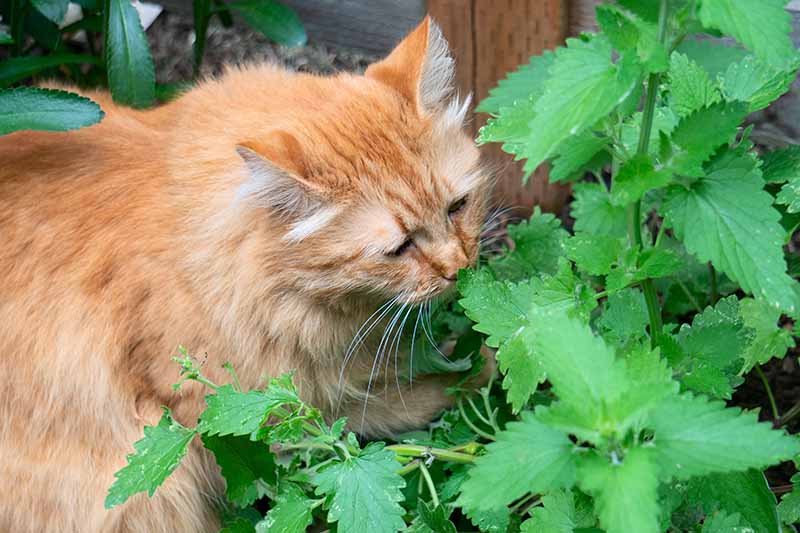
These plants have long been used as herbal remedies in many traditions, often given as tea to children suffering from colic, stress, fever, or tummy aches.
These days, catnip tea is commonly sold by herbal companies who market it as a calming digestive aid, among other uses.

Plants also contain a compound called nepetalactone, a volatile oil that provokes a neurological response in cats, causing them to go temporarily nuts.
Catmint Plant Propagation
Nepeta plants grow and spread easily, and are very easy to propagate in a number of different ways.
From Seed
You can start seeds indoors four to eight weeks before the last frost. Fill three- or four-inch pots with potting mix and press seeds into the soil, barely covering.
Keep moist until seedlings appear in two to three weeks and then place the pots under bright light until they develop at least two sets of true leaves.
You can also direct sow seeds outside before the first frost of fall or in spring after last frost.
You can improve germination by cold stratifying seeds in the freezer overnight and then soaking them in water for 12 to 24 hours prior to planting.
Prepare a garden bed or container with garden soil mixed with an inch of organic matter. Sprinkle seeds on top, barely covering since light aids germination for these plants.
Water lightly and keep moist until sprouts appear, in two to three weeks. Thin seedlings to about 18 inches apart.
It is important to note that not all nepeta species can be started from seed. Some, such as Faassen’s catmint, are sterile and can only be propagated by division or from cuttings. Fortunately, this is easy to do.
By Division
If you have established plants available, divisions are probably the easiest and quickest method of propagating new plants and these can be taken at any time during the growing season, though it’s best to avoid dividing plants in the heat of summer.
Find a section of an established plant with a healthy and mature root system, slice vertically with a garden spade to cut it away from the rest of the plant, and carefully dig it up.
You can also dig up the entire plant, divide it into chunks, and then replant each section directly into the garden or in containers.
Water after replanting and continue to water regularly until established.
You can learn more about how to divide perennials in our guide.
From Cuttings
When new growth appears in the spring, you can select the top three to four inches of a stem and cut at an angle just below a leaf node. Remove the lower leaves from the cutting, leaving the top two to four intact.
To root cuttings in soil, stick the cut end into a four-inch container filled with potting mix and set it in a warm location that receives indirect or filtered light. Water regularly until new growth appears.
This should happen within a few weeks, and serves as a good sign that the cutting has rooted. At this point, it can be transplanted into its permanent location in the garden, or repotted to a larger container.
Cuttings can also be stood up in a glass filled with a couple inches of cool water to root, set in indirect light.
The water should be deep enough to cover at least a couple of leaf nodes, though you should avoid submerging any of the intact leaves. Refresh the water every couple of days and roots should appear in a week or less.
At this point you can transplant them into a four-inch pot filled with sterile potting mix. Water regularly and provide filtered light until new growth appears, then replant as described above.
From Seedlings/Transplanting
Before planting seedlings out in the garden, you can harden them off by moving them for short periods to a sheltered location outside.
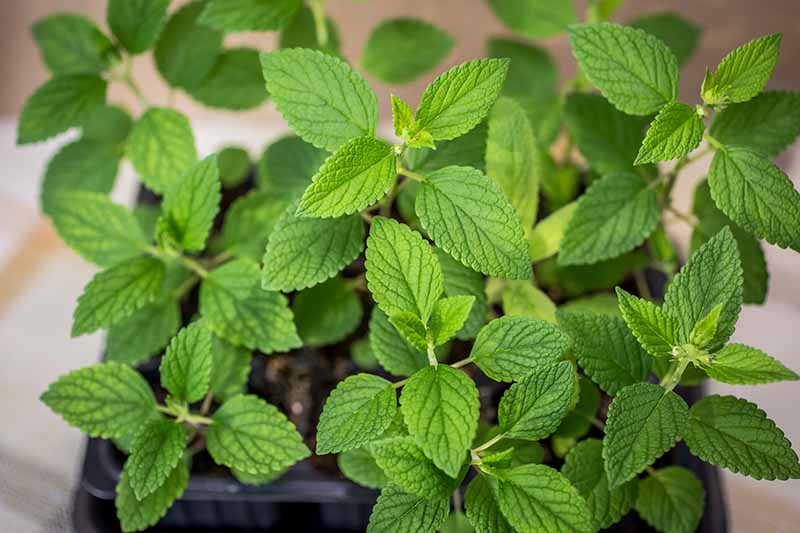
Each day for a week, slowly increase the length of time they spend outside.
After the threat of frost has passed, plant out in the garden in holes dug to the depth of the roots, spacing plants 18 inches apart.
How to Grow Catmint Plants
Most species can tolerate a range of soil types, including sandy and rocky soils. Just be sure the soil is well draining with a pH between 5.0 and 7.5.
Find a location in full sun and work about an inch of compost into the soil. While this isn’t absolutely required, plants do tend to be bushier in soil that is more fertile.
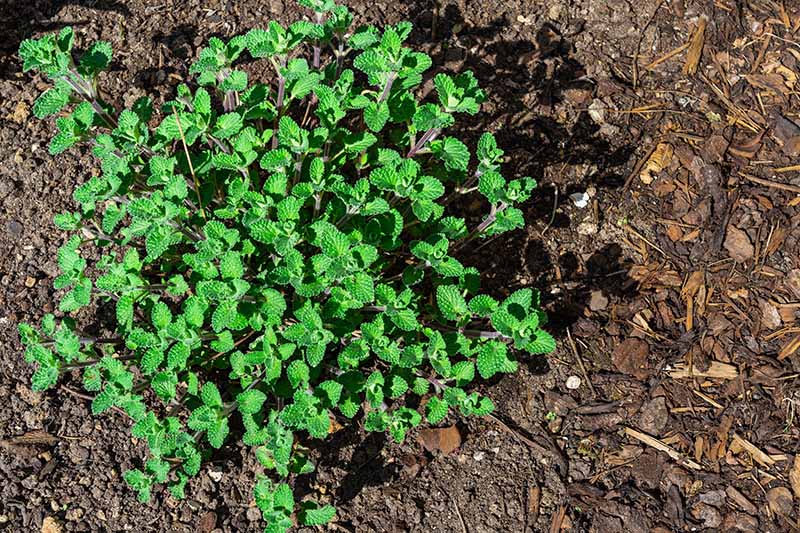
If planting multiples, space about 18 inches apart.
It is also worth noting that some Nepeta species can spread aggressively. You can avoid this by planting in containers or raised beds.
Water well at planting time, and continue to provide about an inch of water a week for the first season. Established plants are drought tolerant and will only need water occasionally, if it hasn’t rained for several weeks.
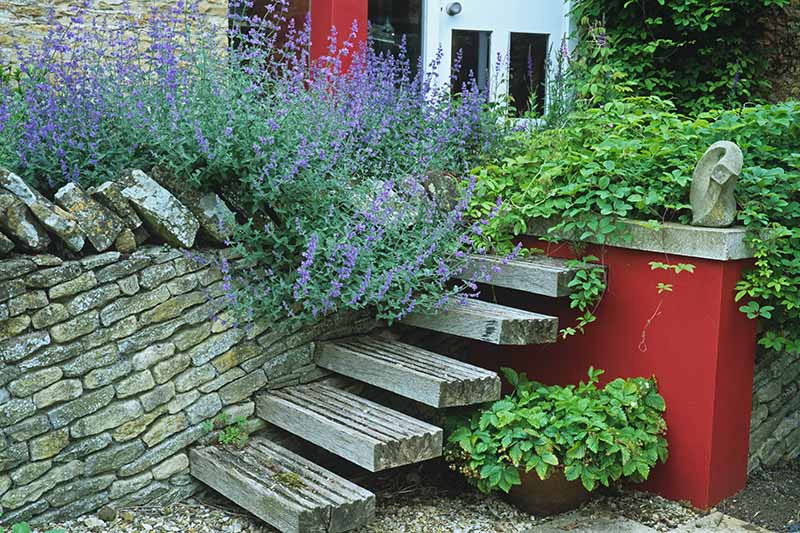
Be sure to avoid overwatering. These plants do not tolerate wet feet!
Adding a couple inches of shredded bark, leaves, or straw mulch around the base of plants each season is a good way to help maintain soil moisture and improve drainage.
Mulch also helps regulate soil temperature and suppresses weeds.
Growing Tips
- Plant in well draining soil with a pH between 5.0 and 7.5.
- Amend soil with an inch of compost to increase vigor.
- Space plants 18 inches apart.
- Provide an inch of water per week the first season. Established plants are drought tolerant.
- Mulch around the base to improve drainage and regulate soil temperature.
Pruning and Maintenance
Nepeta plants begin blooming in early summer and many species flower repeatedly throughout the season.
You can deadhead or cut back plants to keep them from becoming floppy and promote a fuller second bloom.
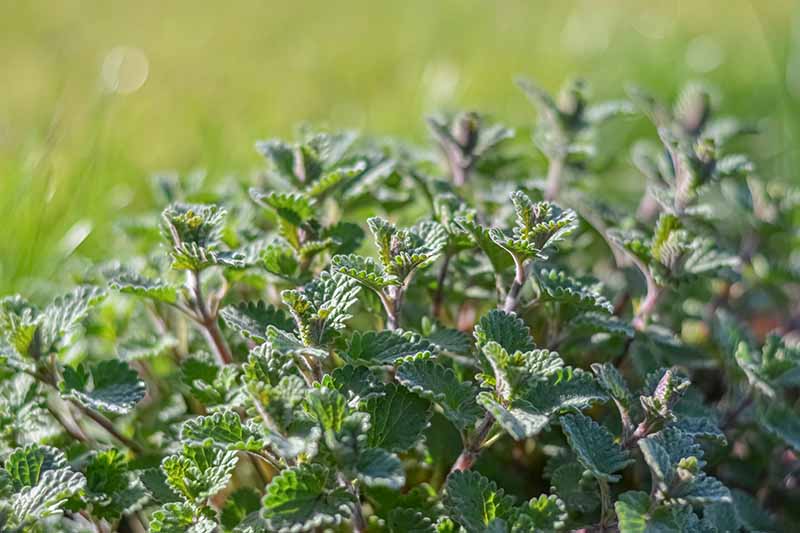
Trim foliage back significantly after flowering, removing about a third of the leaves.
If plants are spreading too much, dividing plants each season as described above will help to keep them in check. You can replant divided sections or give them to a friend.
Species and Cultivars to Select
There are plenty of similarities between the different Nepeta species and cultivars, though there are a few useful distinctions to note when choosing which ones to grow.
Nepeta cataria
If you are interested in the traditional medicinal herb we think of as catnip, N. cataria is the one you want.
This plant has long stalks with large, coarsely toothed, fuzzy leaves and small white, purple, or pink flowers in dense whorls.
The dried herb has a mint-like aroma and makes a delicious tea. It is also the perfect filler for a cat toy.
You can find N. cataria seeds available from True Leaf Market.
Nepeta mussinii
N. mussinii is a compact mounding ornamental that grows up to a foot in height, with gray-green foliage and clusters of half-inch lavender blue flowers that attract bees and butterflies.
You can find heirloom seeds available at Eden Brothers.
Nepeta x faassenii ‘Walker’s Low’
This popular N. x faassenii cultivar features erect spikes of trumpet-shaped lavender blue flowers that bloom all through summer and into fall, as well as dusty gray-green fragrant foliage.
This two to three-foot hardy perennial is perfect for cascading over a wall or rocks, and is a bit less sprawling then some other nepeta varieties.
Seeds of this cultivar are sterile, but you can buy one- to two-year-old plants from Nature Hills Nursery.
Nepeta nervosa ‘Blue Moon’
This showy cultivar of the lesser known N. nervosa is perfect for sunny borders or in mixed container plantings, as it grows in low, dense clumps and tolerates heat well.
It has large spikes of lavender flowers with just a tinge of white on the lips.
Seeds are available from True Leaf Market.
Managing Pests and Disease
Fortunately, there are not too many significant issues with pests and disease for these plants.
In fact, nepetalactone, the compound they produce that attracts cats, has also been found to repel certain types of insects.
The essential oils in catmints are repellent to many common garden pests, such as cabbage loopers, squash bugs, and flea beetles.
Cats
If cats frequent your garden, you may want to consider cat-proofing your plants with a wire fence.
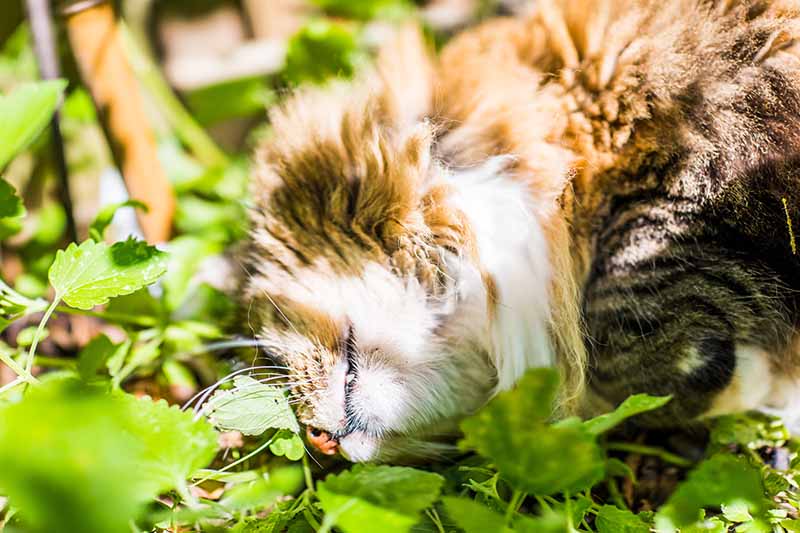
I recently planted some catmint in a sneaky spot out of the way where I thought my cat surely wouldn’t notice it.
Of course, the joke was on me! She found it instantly and proceeded to immediately roll around in it.
Insects and Gastropods
Plants can still experience occasional visits from pests, and it is good to be aware of the signs of these in case you do have a problem.
Slugs can sometimes be attracted to larger leafed species, especially during the springtime. If you notice slugs lurking on your plants, you can handpick them in the evening, especially after wet weather.
You can also try baiting them with beer traps. Just fill a shallow cup with beer and sink it into a hole in the soil. The slugs will be attracted to the beer and fall in.
Spider mites may appear as tiny black dots on the foliage, causing affected leaves to become yellow and dry.
Whiteflies and aphids can potentially congregate on leaves and suck the sap from plants. Both of these pests secrete a sticky substance called honeydew, which can cause sooty mold to develop.
A strong stream of water can be sprayed on plants to remove these pests. If the problem is significant, you can also spray an insecticidal soap on the leaves every couple of days until the infestation subsides.
Disease
Keep an eye out for a few bacterial and fungal diseases that can affect nepeta plants as well.
Bacterial leaf spot, caused by the bacterial pathogen Pseudomonas, can impact plants during cool, wet weather. You may notice yellow ringed spots with red centers on foliage, and disfigured flowers.
Splashing water can spread this disease, so avoid handling plants when they’re wet and limit overhead watering. Remove infected foliage, and in severe cases, remove and dispose of infected plants.
Caused by the Cercospora species of fungi, leaves with blight may develop small spots surrounded by yellow halos that brown over time, eventually causing foliage to wilt and drop. Infected plants should be removed and destroyed.
Always rotate crops if you can, and avoid planting catmint in places that have had issues with blight in the past.
Caused by a number of different pathogens, root rot can cause roots to soften and darken, ultimately causing stems to weaken, and plants to die.
There isn’t a good way to treat root rot, but you can greatly reduce risk by planting in a location with good drainage. Remove and dispose of infected plants.
Septoria leaf spot is a fungal disease caused by Septoria lycopersici. During very wet weather, circular spots with dark edges and gray centers may appear on older leaves, eventually causing leaf drop.
Avoid handling plants when they are wet, keep weeds down, and remove and dispose of infected foliage.
Harvesting and Preserving Catmint
Most Nepeta species are edible. Most commonly, leaves and flowers can be used fresh or dried to make tea.
To harvest, pick the leaves and flowers while plants are blooming during midsummer.
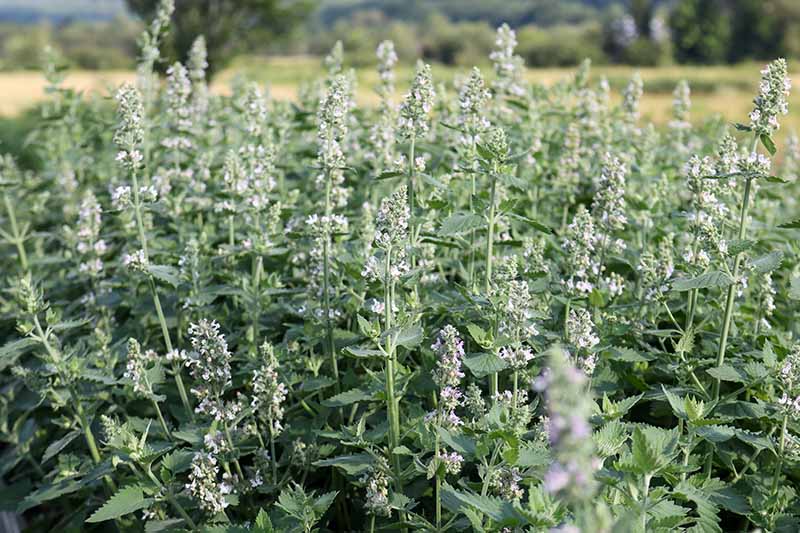
You can harvest the leaves anytime once the plant is at least six inches tall, though they become more flavorful when the plant blooms, as the concentration of oils is the highest during this time.
The best time to pick is late in the day, after the dew has dried. The easiest way to harvest the leaves is by cutting the top third of each stem.
You can take a large harvest all at once, cutting up to a third of each plant, or pick small amounts as needed.
You can dry the leaves and flowers to have available for tea later on, or if you are growing N. cataria, perhaps to make catnip toys for your cats!
The easiest way to dry your harvest is by hanging stems in bundles in a dark, dry place until the leaves can be crumbled and fall from the stems easily.
You can store the dried leaves and flowers in tighty lidded glass jars in a dark cupboard.
Find more tips on drying fresh herbs here.
Best Uses for Catmint Plants
These long-blooming aromatic perennials are perfect for mixed plantings. The smaller mounding varieties especially make for nice borders along perennial flower beds, and companion plants with roses.

You can also consider planting them with annual vegetables, as they attract pollinators and are useful for keeping insects out of the garden.
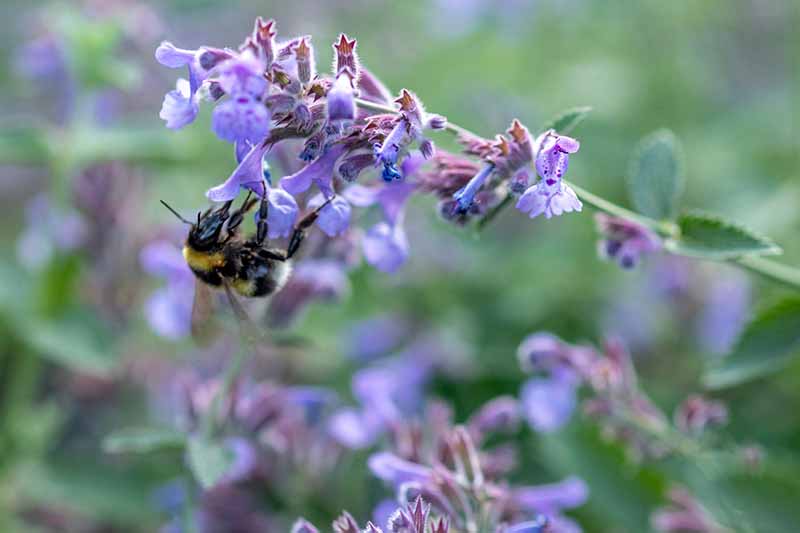
They can easily be grown in containers on the balcony or porch as well. These plants have a nice shape for growing in pots, and can even be brought indoors during winter.
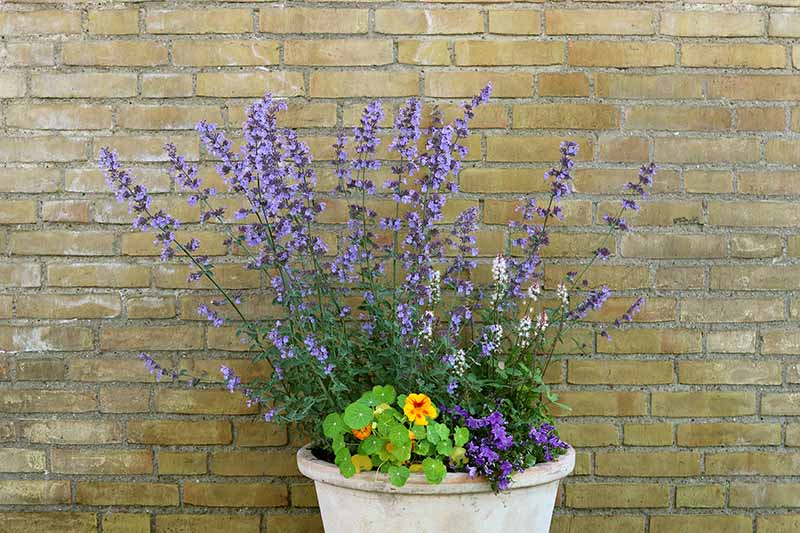
Container planting is also a good idea if you are concerned with aggressive spreading.
Quick Reference Growing Guide
| Plant Type: | Herbaceous perennial | Tolerance: | Drought, frost |
| Native to: | Europe, Africa, Asia | Maintenance | Low |
| Hardiness (USDA Zone): | 3-9 | Soil Type: | Average |
| Bloom Time: | Spring-fall | Soil pH: | 5.0-7.5 |
| Exposure: | Full sun | Soil Drainage: | Well-draining |
| Spacing: | 18 inches | Attracts: | Bees, butterflies, hummingbirds |
| Planting Depth: | Surface sow (seeds), depth of rootball (transplants) | Companion Planting: | Collard greens, hyssop, lavender, potatoes, roses, squash |
| Height: | 2-4 feet | Uses: | Mixed plantings, borders, containers |
| Spread: | 4 feet | Family: | Lamiaceae |
| Water Needs: | Moderate to low | Genus: | Nepeta |
| Common Pests and Disease: | Aphids, slugs, spider mites, whiteflies; Bacterial leaf spot, blight, root rot, septoria leaf spot | Species: | Cataria, faassenii, mussinii (racemosa), nervosa |
Almost Too Easy
Personally, I can’t think of anything much better than an aromatic flowering perennial that both repels pests and attracts pollinators, all while providing beauty and medicine.

Not to mention hours of entertainment for my cats!
With so many uses, the easy-to-grow plants in this genus are an obvious choice.
What Nepeta species do you grow in your garden? Share your favorites in the comments below!
To learn more about growing other mint family plants, check out the following articles next:

